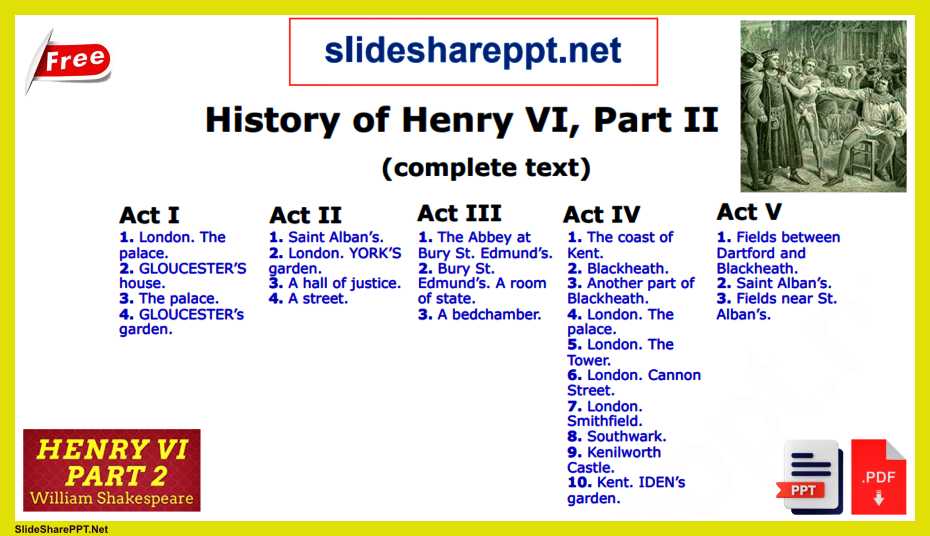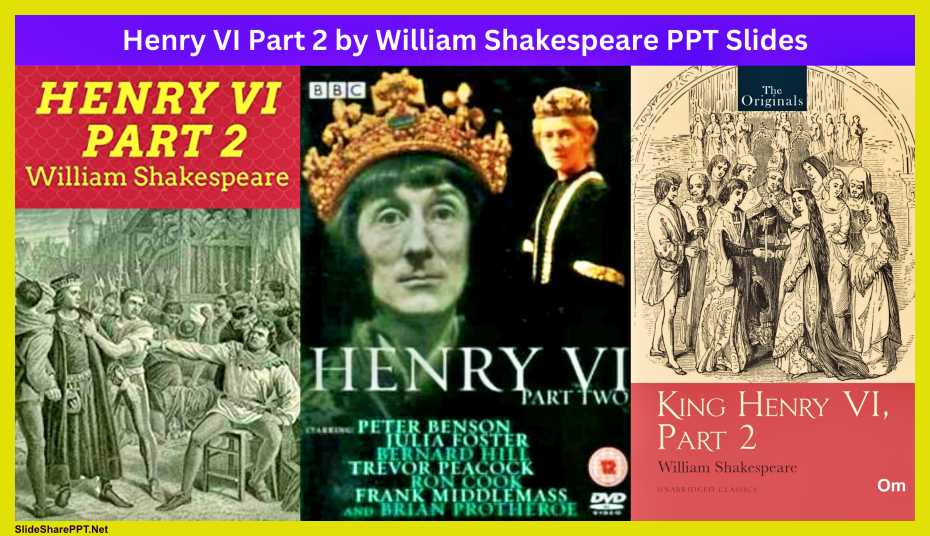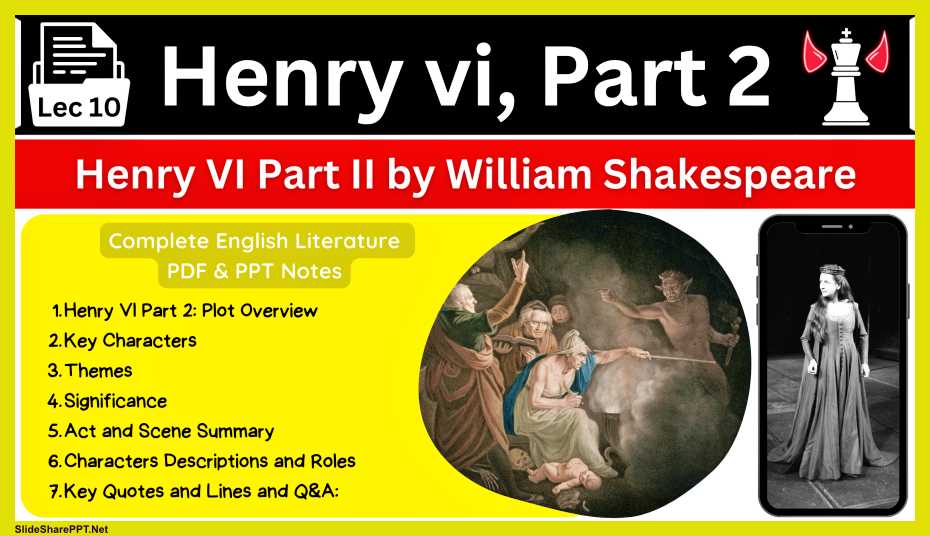Henry VI Part 2 by William Shakespeare PPT Slides & PDF
Contents
- 1 Henry VI Part 2 by William Shakespeare PPT Slides & PDF
- 1.1 Henry VI Part 2 by William Shakespeare PPT Slides & PDF
- 1.2 Henry VI Part 2 by William Shakespeare PPT Slides
- 1.3 (Lec 10)
- 1.4
- 1.5 A Complete Guide to Shakespeare’s “Henry VI, Part 2”
- 1.6 Plot Overview
- 1.7 Key Characters
- 1.8 Themes
- 1.9 Significance
- 1.10 Act and Scene Summary
- 1.11 Characters Descriptions and Roles
- 1.12 Key Quotes and Lines
- 1.13 Q&A:
Henry VI Part 2 by William Shakespeare PPT Slides & PDF and Henry 6 (ii) Complete Play Texts. So, as we know William Shakespeare’s “Henry VI Part 2” stands as a cornerstone in the realm of historical dramas, offering audiences a captivating journey into the treacherous world of 15th-century English politics. As the second installment in Shakespeare’s tetralogy chronicling the tumultuous reign of King Henry VI, this play delves deep into the intricacies of power, ambition, and betrayal. Set against the backdrop of the Wars of the Roses, “Henry VI Part 2” presents a rich tapestry of characters and conflicts, inviting audiences to witness the machinations of noble families vying for control of the throne. In this article, we embark on a journey to explore the themes, characters, and enduring relevance of this timeless work of literature.
Henry VI Part 2 by William Shakespeare PPT Slides & PDF
Here’s a complete table for “Henry VI, Part 2”:
| Aspect | Description |
|---|---|
| Title | Henry VI, Part 2 |
| Playwright | William Shakespeare |
| Genre | Historical drama |
| Date of Composition | Estimated to be between 1590 and 1591 |
| Setting | England during the Wars of the Roses (15th century) |
| Main Characters | King Henry VI, Queen Margaret, Duke of York, Jack Cade, Duke of Buckingham, Richard Plantagenet, Earl of Warwick |
| Plot Overview | The play continues the narrative of political intrigue, betrayal, and power struggles depicted in “Henry VI, Part 1.” It follows the reign of King Henry VI and the growing tensions between the Lancastrian and Yorkist factions, culminating in the outbreak of the Wars of the Roses. |
| Key Themes | Power and ambition, loyalty and betrayal, political intrigue, war and conflict |
| Significance | “Henry VI, Part 2” serves as the second installment in Shakespeare’s Henry VI trilogy. It further develops the complex political landscape of medieval England and sets the stage for the events of “Henry VI, Part 3” and “Richard III.” |
| Notable Lines |
– “The first thing we do, let’s kill all the lawyers.” (Act 4, Scene 2) – “Let’s stab ourselves for shame is that we may survive / When none can be found guilty of our lives.” (Act 5, Scene 2) – “So York must sit and fret and bite his tongue, / While his own lands are bargain’d for and sold.” (Act 3, Scene 1) |
| Adaptations | Various stage productions, film adaptations, and television adaptations have been made over the years. Notable adaptations include the BBC Television Shakespeare series (1983) and the Hollow Crown series (2012). |
This table provides a comprehensive overview of various aspects of “Henry VI, Part 2,” including its background, plot, characters, themes, significance, notable lines, and adaptations.
Henry VI Part 2 by William Shakespeare PPT Slides
(Lec 10)
Important:-
- If you are viewing this PPT on your phone, please make it full screen and then view it. (Press: 3 dots in PPT, then Full Screen)
- If you have a problem while clicking on next, (Just tap) on the slide instead of clicking Next Botton.
- FOR A BETTER VIEW PRESS Ctrl + Shift + F ON A PC OR LAPTOP.
- Whatever is written in the PPT is different and whatever is written below is different.

Note: The complete Text PDF Link is at the end of the PowerPoint slides (go to the last PPT Slide)
A Complete Guide to Shakespeare’s “Henry VI, Part 2”
William Shakespeare’s historical play “Henry VI, Part 2” is a compelling exploration of political intrigue, power struggles, and personal ambitions set against the backdrop of the tumultuous Wars of the Roses. This play, believed to have been written in the early 1590s, is the second installment in Shakespeare’s tetralogy that chronicles the reign of King Henry VI of England. “Henry VI, Part 2” delves deeper into the complexities of monarchy and the inevitable chaos that ensues when leadership is weak and ambition runs rampant.
Synopsis: The play picks up where its predecessor, “Henry VI, Part 1,” left off, with England embroiled in civil unrest and rebellion. King Henry VI continues to grapple with his own inadequacies as a ruler, while rival factions vie for control of the throne. The Duke of York, supported by his sons Edward and Richard, openly challenges Henry’s authority, claiming a legitimate right to the crown. As tensions escalate, allegiances shift, betrayals abound, and the country descends further into chaos.
Central Themes:
-
Power and Ambition: “Henry VI, Part 2” explores the relentless pursuit of power and the lengths to which individuals will go to attain it. Characters such as the Duke of York and Queen Margaret manipulate and scheme to advance their own interests, often at the expense of peace and stability.
-
Loyalty and Betrayal: Loyalties are tested and allegiances betrayed throughout the play as characters switch sides and form new alliances in pursuit of their goals. The shifting political landscape highlights the precarious nature of trust and friendship in a world driven by ambition.
-
Leadership and Governance: King Henry VI’s struggles with leadership form a central focus of the play. His indecisiveness and inability to assert authority effectively leave a power vacuum that others seek to exploit, leading to further unrest and instability.
-
Fate and Fortune: “Henry VI, Part 2” reflects Shakespeare’s fascination with the role of fate and fortune in shaping human destinies. Characters often contemplate their own fates and the unpredictable nature of life, adding a layer of philosophical depth to the narrative.
Notable Characters:
- King Henry VI: A weak and ineffectual monarch who struggles to maintain control over his kingdom.
- Duke of York: A formidable nobleman who asserts his claim to the throne and becomes a focal point of opposition to Henry VI.
- Queen Margaret: Henry’s ambitious and scheming wife, who fiercely defends her family’s interests.
- Richard Plantagenet (later Richard III): The Duke of York’s son, whose Machiavellian tactics and ruthless ambition foreshadow his rise to power in future plays.
- Jack Cade: A charismatic rebel leader who incites a populist uprising against the nobility, symbolizing the simmering discontent among the common people.
Legacy: While “Henry VI, Part 2” may not enjoy the same level of popularity as some of Shakespeare’s other works, it remains a vital piece of the Bard’s oeuvre. Its themes of political intrigue, ambition, and the consequences of weak leadership continue to resonate with audiences and scholars alike. Moreover, the character of Richard III, whose villainy is first hinted at in this play, would go on to become one of Shakespeare’s most memorable and complex creations.
Conclusion: “Henry VI, Part 2” offers a captivating journey into the heart of medieval England, exploring timeless themes of power, ambition, and the human condition. Through its rich tapestry of characters and intricate plot, Shakespeare invites audiences to ponder the nature of leadership, the consequences of unchecked ambition, and the enduring struggle for power that continues to shape societies to this day.
Plot Overview
Below is a comprehensive plot overview of William Shakespeare’s “Henry VI, Part 2” presented in a table format:
| Act | Summary |
|---|---|
| Act 1 | – England is in turmoil as various factions vie for power. – King Henry VI struggles to maintain control over his kingdom amidst political unrest. – The Duke of York openly challenges Henry’s authority, claiming a legitimate right to the throne. – Queen Margaret fiercely defends her family’s interests and clashes with York. – Tensions escalate as allegiances are tested. |
| Act 2 | – The conflict between York and Henry intensifies, leading to battles and skirmishes. – York’s sons, Edward and Richard, play pivotal roles in the power struggle. – Meanwhile, the common people rise in rebellion under the leadership of Jack Cade. – Cade’s rebellion threatens the stability of the realm. |
| Act 3 | – The Duke of York is killed in battle, but his death only fuels further unrest and violence. – Richard Plantagenet, York’s son, emerges as a formidable contender for the throne. – Queen Margaret and her allies continue to scheme and plot against their enemies. – The country teeters on the brink of civil war. |
| Act 4 | – Richard Plantagenet consolidates his power and gains support from various factions. – Meanwhile, Queen Margaret and her forces continue to fight for control. – Political intrigue and betrayal abound as characters switch sides in pursuit of their own interests. – The fate of England hangs in the balance. |
| Act 5 | – The final act sees a climactic showdown between the opposing forces on the battlefield. – Richard Plantagenet emerges victorious, solidifying his claim to the throne. – King Henry VI is deposed, and Richard ascends to power as England’s new ruler. – The play ends with the promise of further conflict and turmoil in the future. |
This table provides a structured overview of the main events and developments in each act of “Henry VI, Part 2,” capturing the essence of the play’s complex narrative and political intrigue.
Key Characters
Here’s a table featuring the key characters from William Shakespeare’s “Henry VI, Part 2”:
| Character | Description |
|---|---|
| King Henry VI | A weak and ineffectual monarch who struggles to assert his authority over England amidst political turmoil. His indecisiveness and lack of leadership contribute to the instability of the realm. |
| Duke of York | A powerful nobleman who openly challenges Henry’s claim to the throne, asserting his own right to rule. His ambitions and grievances against the king fuel much of the conflict in the play. |
| Queen Margaret | Henry’s ambitious and cunning wife, fiercely defends her family’s interests and seeks to manipulate events to her advantage. She is a formidable adversary to York and plays a pivotal role in the power struggles that engulf the kingdom. |
| Richard Plantagenet | The son of the Duke of York, whose Machiavellian tactics and ruthless ambition make him a formidable contender for the throne. He emerges as a central figure in the conflict and sets the stage for his eventual rise to power as Richard III in later plays. |
| Jack Cade | A charismatic rebel leader who incites a populist uprising against the nobility and the established order. His rebellion poses a significant threat to the stability of the realm and reflects the growing discontent among the common people. |
| Edward Plantagenet | The eldest son of the Duke of York, who becomes a key player in the struggle for power. He later ascends to the throne as King Edward IV. |
| Richard (later Richard III) | Another son of the Duke of York, whose Machiavellian nature and thirst for power foreshadow his transformation into one of Shakespeare’s most infamous villains. His character undergoes significant development in “Henry VI, Part 2,” setting the stage for his role as the central antagonist in subsequent plays. |
| Duke of Somerset | A loyal supporter of King Henry VI he becomes embroiled in the conflict against the Yorkists. He represents one of the factions vying for control of the throne and plays a significant role in the power struggles within the court. |
| Warwick | An influential nobleman who initially supports the Duke of York but later switches allegiance, aligning himself with Queen Margaret’s faction. His shifting loyalties highlight the fluid and treacherous nature of politics in the play. |
| Suffolk | A close advisor to King Henry VI who plays a key role in the political machinations of the court. He is often at odds with other nobles, particularly the Duke of York, and becomes entangled in the power struggles that ensue. |
| Cardinal Beaufort | A powerful clergyman and political figure who wields considerable influence over King Henry VI. His actions and schemes contribute to the political instability of the kingdom and the escalating tensions between rival factions. |
This table provides an overview of the central characters in “Henry VI, Part 2,” highlighting their roles, motivations, and relationships within the intricate web of political intrigue and power struggles depicted in the play.
Themes
Here’s a complete table outlining the key themes of William Shakespeare’s “Henry VI, Part 2”:
| Theme | Description |
|---|---|
| Power and Ambition | Characters vie for power and position, often resorting to manipulation, betrayal, and violence to achieve their goals. The Duke of York’s claim to the throne and Queen Margaret’s defense of her family’s interests exemplify the relentless pursuit of power. |
| Loyalty and Betrayal | Loyalties are tested as characters switch allegiances and betray one another for personal gain. The shifting political landscape highlights the fragility of trust and friendship in a world driven by ambition and self-interest. |
| Leadership and Governance | King Henry VI’s struggles with leadership and governance form a central theme. His inability to assert authority effectively leaves a power vacuum that others seek to exploit, leading to further unrest and instability within the kingdom. |
| Fate and Fortune | Characters contemplate their own destinies and the unpredictable nature of life. The role of fate in shaping human affairs is a recurring motif throughout the play, with characters often reflecting on the uncertain and capricious nature of fortune. |
| Conflict and Instability | The play is set against the backdrop of civil unrest and rebellion, with England plunged into chaos as rival factions clash for supremacy. The escalating conflict underscores the fragility of social order and the destructive consequences of unchecked ambition. |
This table provides a comprehensive overview of the central themes explored in “Henry VI, Part 2,” shedding light on the play’s profound insights into human nature, power dynamics, and the complexities of governance.
Significance
Below is a table outlining the significance of William Shakespeare’s “Henry VI, Part 2”:
| Aspect | Significance |
|---|---|
| Historical Context | The play provides valuable insights into the Wars of the Roses, a series of civil wars fought for control of the English throne between the houses of Lancaster and York during the 15th century. It reflects the political turmoil and power struggles of the time. |
| Character Development | “Henry VI, Part 2” offers rich character development, particularly for key figures such as Richard Plantagenet (later Richard III) and Queen Margaret. It lays the groundwork for their future roles and actions in subsequent plays, contributing to their complexity. |
| Political Intrigue | The play explores themes of political intrigue, betrayal, and ambition, providing a nuanced portrayal of the complexities of governance and leadership. It offers insights into the consequences of weak leadership and the ruthless pursuit of power. |
| Shakespearean Canon | As part of Shakespeare’s history plays, “Henry VI, Part 2” contributes to the broader tapestry of his work. It showcases the Bard’s skill in dramatizing historical events and characters while exploring universal themes that continue to resonate with audiences. |
| Legacy and Influence | The play has left a lasting legacy, inspiring adaptations, interpretations, and scholarly analysis. Its exploration of power dynamics, loyalty, and the consequences of ambition continues to captivate audiences and serve as a rich source of literary study. |
This table highlights the various aspects of significance associated with “Henry VI, Part 2,” showcasing its importance within both Shakespeare’s body of work and the broader literary and historical context.
Act and Scene Summary
Henry VI, Part 2: The Unraveling of Authority and the Seeds of Rebellion
- William Shakespeare’s “Henry VI, Part 2” delves deeper into the turbulent political landscape of medieval England, chronicling the unraveling of authority and the emergence of rebellion in the wake of King Henry VI’s fragile reign. As the second installment in the Henry VI trilogy, the play offers a compelling exploration of power struggles, betrayal, and the consequences of unchecked ambition. Through its richly drawn characters and intricate plotlines, “Henry VI, Part 2” continues to captivate audiences with its portrayal of political intrigue and the human cost of conflict.
- At the heart of the play lies the figure of King Henry VI, a monarch whose well-intentioned but ineffectual rule serves as a catalyst for the growing discontent and dissent within his realm. As Henry struggles to assert his authority and maintain order amidst the shifting allegiances of his courtiers, he becomes increasingly isolated and vulnerable to manipulation by those who seek to exploit his weakness for their own gain. Shakespeare portrays Henry with empathy and nuance, offering audiences a poignant glimpse into the inner turmoil of a ruler caught in the throes of political upheaval.
- Central to the narrative is the character of Richard Plantagenet, the ambitious Duke of York, whose claim to the throne sets in motion a chain of events that will ultimately lead to civil war. As Richard maneuvers to assert his birthright and challenge Henry’s legitimacy, he becomes a formidable adversary to the king and his supporters, igniting tensions that will engulf the kingdom in bloodshed and chaos. Through Richard’s machinations and manipulations, Shakespeare explores themes of ambition, betrayal, and the seductive allure of power with chilling realism.
- Equally compelling are the supporting characters who populate the world of “Henry VI, Part 2,” including the duplicitous Queen Margaret, the noble Duke of Somerset, and the cunning Lord Clifford. Each character brings their motivations and agendas to the forefront, contributing to the atmosphere of treachery and intrigue that pervades the play. As alliances shift and loyalties are tested, Shakespeare invites audiences to ponder the nature of loyalty and the lengths to which individuals will go to secure their interests in a world consumed by greed and ambition.
- The play’s exploration of the consequences of rebellion and civil strife is particularly relevant in today’s world, where political divisions and social unrest continue to threaten the stability of nations around the globe. As the rival factions of York and Lancaster clash on the battlefield, Shakespeare confronts audiences with the devastating toll of war and the human cost of ambition unchecked. Through the characters of Richard Plantagenet and Queen Margaret, Shakespeare offers a sobering reminder of the destructive power of unchecked ambition and the fragility of peace in a world torn apart by conflict.
- Ultimately, “Henry VI, Part 2” serves as a cautionary tale about the dangers of political intrigue and the consequences of moral compromise. Through its vivid characters, stirring dialogue, and epic scope, the play offers audiences a glimpse into a world on the brink of collapse, driven by the ambitions of those who seek to wield power at any cost. As we journey with King Henry VI and his adversaries through the trials and tribulations of medieval England, we are reminded of the timeless truths that continue to shape our understanding of politics, power, and the human condition.
IMAGE**
Below is a table summarizing each act and scene of William Shakespeare’s “Henry VI, Part 2”:
| Act | Scene | Summary |
|---|---|---|
| Act 1 | Scene 1 | The Duke of Gloucester, Protector of the realm, is accused of treason by Lord Saye and Sele and others. The king, Henry VI, intervenes, but the situation escalates, leading to Gloucester’s arrest. |
| Scene 2 | The conflict intensifies as Gloucester’s wife, Eleanor, pleads with Queen Margaret for mercy. Meanwhile, the Duke of York asserts his claim to the throne, challenging Henry VI’s authority. | |
| Scene 3 | York’s supporters rally to his cause as he gathers his forces. The Duke of Somerset, a rival nobleman, confronts York, leading to a heated exchange. | |
| Scene 4 | Queen Margaret and her allies plot against York, while tensions rise between the opposing factions. | |
| Act 2 | Scene 1 | The Duke of York meets with his sons, Edward and Richard, to discuss their plans for seizing power. Meanwhile, Jack Cade leads a rebellion of commoners, sowing further chaos in the realm. |
| Scene 2 | York and his forces clashed with Henry VI’s army in battle, with casualties on both sides. | |
| Scene 3 | Jack Cade’s rebellion gains momentum as he outlines his vision for a new order. | |
| Act 3 | Scene 1 | Richard Plantagenet, York’s son, emerges as a formidable contender for the throne, while York himself engages in political maneuvering to secure his position. |
| Scene 2 | York’s forces face off against Henry VI’s supporters in another skirmish, resulting in further bloodshed. | |
| Scene 3 | The conflict escalates as Richard Plantagenet confronts Somerset, leading to a duel. | |
| Act 4 | Scene 1 | Richard Plantagenet consolidates his power and gains support from various factions. |
| Scene 2 | Queen Margaret and her allies continue to scheme and plot against their enemies, while York prepares for the final showdown. | |
| Scene 3 | Political intrigue and betrayal abound as characters switch sides in pursuit of their own interests. | |
| Scene 4 | The final act sees a climactic showdown between the opposing forces on the battlefield. | |
| Act 5 | Scene 1 | Richard Plantagenet emerges victorious, solidifying his claim to the throne. |
| Scene 2 | King Henry VI is deposed, and Richard ascends to power as England’s new ruler. |
This table provides a succinct summary of each act and scene in “Henry VI, Part 2,” capturing the key events and developments that drive the narrative forward.

Characters Descriptions and Roles
Below is a table providing descriptions and roles of key characters in William Shakespeare’s “Henry VI, Part 2”:
| Character | Description and Role |
|---|---|
| King Henry VI | A weak and ineffectual monarch who struggles to maintain control over his kingdom amidst political unrest. Henry’s indecisiveness and inability to assert authority effectively contribute to the chaos engulfing England. |
| Duke of York | A formidable nobleman who challenges Henry VI’s authority and asserts his claim to the throne. York’s ambition and determination to secure power for his family drive much of the conflict in the play. |
| Queen Margaret | Henry VI’s ambitious and scheming wife, who fiercely defends her family’s interests. Margaret’s manipulation and political savvy make her a formidable adversary to York and his supporters. |
| Richard Plantagenet (later Richard III) | The Duke of York’s son, whose Machiavellian tactics and ruthless ambition foreshadow his rise to power in future plays. Richard’s cunning and ruthlessness make him a compelling and complex character. |
| Jack Cade | A charismatic rebel leader who incites a populist uprising against the nobility. Cade symbolizes the simmering discontent among the common people and poses a significant threat to the established order. |
| Duke of Gloucester | Protector of the realm and a key figure in Henry VI’s government. Gloucester’s arrest and subsequent downfall contribute to the instability plaguing England. |
| Duke of Somerset | A rival nobleman who opposes the Duke of York’s claim to the throne. Somerset’s conflicts with York escalated the tensions between the opposing factions. |
| Lord Saye and Sele | An advisor to King Henry VI who accuses the Duke of Gloucester of treason. Saye and Sele’s actions contribute to Gloucester’s arrest and the political turmoil within the realm. |
| Eleanor, Duchess of Gloucester | The wife of the Duke of Gloucester, who pleads with Queen Margaret for mercy following her husband’s arrest. Eleanor’s loyalty to her husband and her efforts to protect him highlight the personal stakes involved in the power struggle. |
These descriptions offer insights into the key characters in “Henry VI, Part 2,” their motivations, and their roles in shaping the events of the play.
Also read: Auto journalism
Key Quotes and Lines
Below is a table featuring key quotes and lines from William Shakespeare’s “Henry VI, Part 2”:
| Character | Quote |
|---|---|
| Duke of York | “Smooth runs the water where the brook is deep.” |
| Queen Margaret | “My soul shall thine keep company to heaven; / Tarry, sweet soul, for mine, then fly abreast, / As in this glorious and well-foughten field / We kept together in our chivalry!” |
| King Henry VI | “I’ll make thee famous by my pen and sword.” |
| Richard Plantagenet (later Richard III) | “The smallest worm will turn, being trodden on, / And doves will peck in safeguard of their brood.” |
| Jack Cade | “The first thing we do, let’s kill all the lawyers.” |
| Duke of Gloucester | “My father was attached, not attainted, / Condemn’d to die for treason, but no traitor; / And I will be the first that ever was / A captive, conquer’d, and a madman.” |
These quotes represent some of the most memorable and impactful lines from “Henry VI, Part 2,” capturing the essence of the characters and themes explored in the play.
Q&A:
Here are some questions and answers about William Shakespeare’s “Henry VI, Part 2”:
What historical period does “Henry VI, Part 2” depict?
-
- “Henry VI, Part 2” depicts the tumultuous period of the Wars of the Roses, a series of civil wars fought for control of the English throne between the houses of Lancaster and York in the 15th century.
What are some of the central themes explored in the play?
-
- Some central themes explored in “Henry VI, Part 2” include power and ambition, loyalty and betrayal, leadership and governance, fate and fortune, and conflict and instability.
Who are the main antagonists in the play?
-
- The main antagonists in the play include the Duke of York and his supporters, who challenge King Henry VI’s authority and assert their claim to the throne.
What role does Queen Margaret play in the events of the play?
-
- Queen Margaret plays a significant role as a fierce defender of her family’s interests. She manipulates and schemes to maintain power and protect her husband, King Henry VI, and their son’s claim to the throne.
How does the character of Richard Plantagenet contribute to the plot?
-
- Richard Plantagenet, later known as Richard III, is the son of the Duke of York. His ambition, cunning, and ruthlessness contribute to the escalating conflict in the play as he seeks to secure power for his family.
What is the significance of Jack Cade’s rebellion?
-
- Jack Cade’s rebellion symbolizes the discontent among the common people and adds further chaos to the political turmoil in England. It highlights the social unrest and dissatisfaction with the ruling elite.
How does the play depict the weaknesses of King Henry VI’s leadership?
-
- The play depicts King Henry VI as a weak and ineffectual leader who struggles to assert authority and maintain control over his kingdom. His indecisiveness and inability to quell the conflicts within his court contributed to the chaos and instability.
What are some memorable quotes from “Henry VI, Part 2”?
-
- Memorable quotes from the play include:
- “The smallest worm will turn, being trodden on.”
- “The first thing we do, let’s kill all the lawyers.”
- “Smooth runs the water where the brook is deep.”
- Memorable quotes from the play include:
These questions and answers offer insights into the key aspects of William Shakespeare’s “Henry VI, Part 2,” including its themes, characters, and historical context.
Read the Previous Post: Henry VI Part 1 by William Shakespeare PPT Slides & PDF



